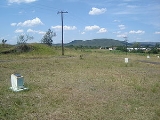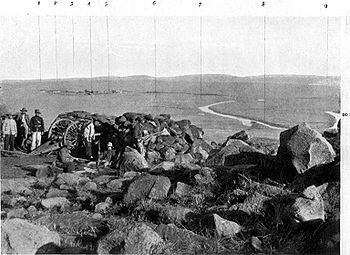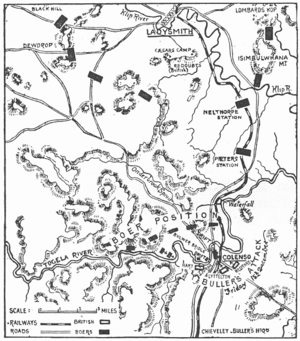
Colenso, KwaZulu-Natal
Encyclopedia
Colenso is a town
Town
A town is a human settlement larger than a village but smaller than a city. The size a settlement must be in order to be called a "town" varies considerably in different parts of the world, so that, for example, many American "small towns" seem to British people to be no more than villages, while...
in KwaZulu-Natal
KwaZulu-Natal
KwaZulu-Natal is a province of South Africa. Prior to 1994, the territory now known as KwaZulu-Natal was made up of the province of Natal and the homeland of KwaZulu....
, South Africa
South Africa
The Republic of South Africa is a country in southern Africa. Located at the southern tip of Africa, it is divided into nine provinces, with of coastline on the Atlantic and Indian oceans...
. It is located on the southern bank of the Tugela
Tugela
Tugela is a brown Thoroughbred mare. Bred by Khalid Abdullah's prominent Juddmonte Farms. Tugela was sired by Riverman and out of Rambushka who in turn was a daughter of Epsom Derby winner, Roberto, a two-time Leading sire in France.Tugela is best known as the dam of Makybe Diva , the champion...
River. The original settlement was contained within a loop on the river, but it subsequently expanded southwards and eastwards. It lies on the main Durban
Durban
Durban is the largest city in the South African province of KwaZulu-Natal and the third largest city in South Africa. It forms part of the eThekwini metropolitan municipality. Durban is famous for being the busiest port in South Africa. It is also seen as one of the major centres of tourism...
- Johannesburg
Johannesburg
Johannesburg also known as Jozi, Jo'burg or Egoli, is the largest city in South Africa, by population. Johannesburg is the provincial capital of Gauteng, the wealthiest province in South Africa, having the largest economy of any metropolitan region in Sub-Saharan Africa...
railway line some 190 km north-west of Durban.
History
The settlement was established in 1855 at a Commando Drift,a ford on the Tugela River
Tugela River
The Tugela River is the largest river in KwaZulu-Natal Province, South Africa. The river originates in the Drakensberg Mountains, Mont-aux-Sources, and plunges 947 metres down the Tugela Falls...
in the then Colony of Natal
Colony of Natal
The Colony of Natal was a British colony in south-eastern Africa. It was proclaimed a British colony on May 4, 1843 after the British government had annexed the Boer Republic of Natalia, and on 31 May 1910 combined with three other colonies to form the Union of South Africa, as one of its...
on the main road between Durban
Durban
Durban is the largest city in the South African province of KwaZulu-Natal and the third largest city in South Africa. It forms part of the eThekwini metropolitan municipality. Durban is famous for being the busiest port in South Africa. It is also seen as one of the major centres of tourism...
in the south and the South African Republic
South African Republic
The South African Republic , often informally known as the Transvaal Republic, was an independent Boer-ruled country in Southern Africa during the second half of the 19th century. Not to be confused with the present-day Republic of South Africa, it occupied the area later known as the South African...
(now Gauteng Province) and Orange Free State
Orange Free State
The Orange Free State was an independent Boer republic in southern Africa during the second half of the 19th century, and later a British colony and a province of the Union of South Africa. It is the historical precursor to the present-day Free State province...
to the north. The settlement was a stop-over point before or after fording the river (which is some 60 – 70 metres wide at that point). It was named after the Anglican bishop of Natal and champion of the Zulu cause, John William Colenso
John William Colenso
John William Colenso , first Anglican bishop of Natal, mathematician, theologian, Biblical scholar and social activist.-Biography:Colenso was born at St Austell, Cornwall, on 24 January 1814...
. On account of the ferry, the Zulu named the settlement eSkipeni - Place of the Boat.
In October 1879 the ford was replaced by the Bulwer Bridge, named after Sir Henry Bulwer, the then Lieutenant Governor of Natal.
On 21 June 1886 the railway line from Durban to Ladysmith
Ladysmith, KwaZulu-Natal
Ladysmith is a city in the Uthukela District of KwaZulu-Natal, South Africa. It is north-west of Durban and south of Johannesburg. Important industries in the area include food processing, textile and tyre production...
(20 km north of Colenso) which crossed the Tugela River at Colenso was opened.
During the Anglo-Boer War
Second Boer War
The Second Boer War was fought from 11 October 1899 until 31 May 1902 between the British Empire and the Afrikaans-speaking Dutch settlers of two independent Boer republics, the South African Republic and the Orange Free State...
(1899–1902) the town, being located at the point where the main north-south transport route crossed the main east-west river, was one of focal points in the relief of Ladysmith. In 1922 work commenced on the building of a power station which was to be the main industry of the town for many years. The settlement was proclaimed a township in 1926 and received borough status in 1958. The power station was decommissioned in 1985 which caused a stagnation of the town.
In 1990 the Colenso Municipality was granted a flag by the Bureau for Heraldy. The blazon described the flag as "A regtangular [sic] flag proportion 3:2, consisting of a black hoist panel 1/5 the length of the flag and a yellow charged with a blue fess wavy, thereupon another of white".
The Afrikaans language version of the grant also mentions a six-pointed white star in the canton
Flag terminology
Flag terminology is a jargon used in vexillology, the study of flags, to describe precisely the parts, patterns, and other attributes of flags and their display.-Description of standard flag parts and terms:...
of the flag. The colours black and yellow (old gold) are also the colours of the Escom club. The blue and white wavy line almost certainly alures to the Tugela River.
In the 1990s, the building of a new toll road between Durban and Johannesburg which crossed the Tugela some 16 km to the west of Colenso led to further stagnation as trade from through traffic was removed.
Colenso and the Boer War

Petrus Jacobus Joubert
Petrus Jacobus Joubert , better known as Piet Joubert was Commandant-General of the South African Republic from 1880 to 1900.-Early life:...
crossed the border into the Natal Colony and rapidly advanced to the Tugela river, laying siege to Ladysmith
Ladysmith, KwaZulu-Natal
Ladysmith is a city in the Uthukela District of KwaZulu-Natal, South Africa. It is north-west of Durban and south of Johannesburg. Important industries in the area include food processing, textile and tyre production...
, some 20 km north of the river and entrapping some 8,000 British regulars. On 15 November a raiding party ambushed an armoured train at Frere, 11 km south of Colenso taking 70 prisoners including Winston Churchill
Winston Churchill
Sir Winston Leonard Spencer-Churchill, was a predominantly Conservative British politician and statesman known for his leadership of the United Kingdom during the Second World War. He is widely regarded as one of the greatest wartime leaders of the century and served as Prime Minister twice...
. After another raiding party was surprised on 23 November at Willow Grange, 40 km to the south of Colenso, the Boers withdrew to a position behind the Tugela River.
Rough country lay between the Tugela and Ladysmith with the tops of the hills reaching more the 200 m above the river bed. Apart from some hills downstream (east and north-east) of Colenso (including the peaks of Hlangwane and Monte Cristo), the land the south of the river was relatively flat. When General Sir Redvers Buller
Redvers Buller
General Sir Redvers Henry Buller VC GCB GCMG was an English recipient of the Victoria Cross, the highest and most prestigious award for gallantry in the face of the enemy that can be awarded to British and Commonwealth forces....
arrived in November to break the Siege of Ladysmith
Siege of Ladysmith
The Siege of Ladysmith was a protracted engagement in the Second Boer War, taking place between 30 October 1899 and 28 February 1900 at Ladysmith, Natal.-Background:...
, it was obvious that he would have to cross the river and then march across the rough country before he could achieve his objective.
Buller's first attempt at crossing the river was the Battle of Colenso
Battle of Colenso
The Battle of Colenso was the third and final battle fought during the Black Week of the Second Boer War. It was fought between British and Boer forces from the independent South African Republic and Orange Free State in and around Colenso, Natal, South Africa on 15 December 1899.Inadequate...
. From the British point of view, the battle was a fiasco. On the western flank the British forces suffered considerable losses when the Irish Brigade were trapped in a loop in the river 3 km upstream for Colenso. In the centre they lost six guns while on the eastern flank, Buller ordered his men to retreat after the Boers had abandoned Hlangwane hill. Victoria Crosses were awarded to William Babtie
William Babtie
Lieutenant General Sir William Babtie VC KCB KCMG was a Scottish recipient of the Victoria Cross, the highest and most prestigious award for gallantry in the face of the enemy that can be awarded to British and Commonwealth armed forces...
, Walter Norris Congreve
Walter Norris Congreve
General Sir Walter Norris Congreve VC KCB MVO DL was an English recipient of the Victoria Cross, the highest and most prestigious award for gallantry in the face of the enemy that can be awarded to British and Commonwealth forces...
(whose son also won a VC), George Ravenhill
George Ravenhill
George Ravenhill VC was an English recipient of the Victoria Cross, the highest award for gallantry in the face of the enemy that can be awarded to British and Commonwealth forces. Ravenhill is one of eight men whose VCs were involuntarily forfeited.-Military service:Ravenhill was born in Aston,...
(VC later forfeited), Hamilton Lyster Reed
Hamilton Lyster Reed
Major General Hamilton Lyster Reed VC, CB, CMG, was an Irish recipient of the Victoria Cross, the highest and most prestigious award for gallantry in the face of the enemy that can be awarded to British and Commonwealth forces....
, Freddy Roberts, son of Lord Roberts VC
Frederick Roberts, 1st Earl Roberts
Field Marshal Frederick Sleigh Roberts, 1st Earl Roberts, Bt, VC, KG, KP, GCB, OM, GCSI, GCIE, KStJ, PC was a distinguished Indian born British soldier who regarded himself as Anglo-Irish and one of the most successful British commanders of the 19th century.-Early life:Born at Cawnpore, India, on...
(posthumous) and Harry Norton Schofield
Harry Norton Schofield
Lieutenant-Colonel Harry Norton Schofield VC was an English recipient of the Victoria Cross, the highest and most prestigious award for gallantry in the face of the enemy that can be awarded to British and Commonwealth forces.-Details:Schofield was 34 years old, and a captain in the Royal...
for gallantry during the battle. Many of the British dead from the Battle of Colenso are now interred in the Ambleside Cemetery close to the point where the Irish Brigade were trapped.

Battle of Spion Kop
The Battle of Spion Kop was fought about west-south-west of Ladysmith on the hilltop of Spioenkop along the Tugela River, Natal in South Africa from 23–24 January 1900...
between 20 and 24 January 1900 and at Vaalkrans
Battle of Vaal Krantz
The Battle of Vaal Krantz was the third failed attempt by General Redvers Buller's British army to fight its way past Louis Botha's army of Boer irregulars and lift the Siege of Ladysmith...
between 5 and 7 February 1900. Both ended in disaster for the British. The Boers meanwhile strengthened their position in the hills between the Tugela and Ladysmith and they also occupied the hills to the south of the river, downstream of Colenso.
By now troops from Britain, India and the other colonies were pouring into South Africa. Buller had 28,000 men at his disposal while the Boers had 6,000 men to defend the Tugela. In the first phase of the Battle of Tugela Heights which lasted from 12 February 1900 until 28 February 1900, the British captured all of the South Bank, including the peaks of Hlangwane and Monte Cristo. On 21 February, the British crossed the Tugela about ten kilometres downstream from Colenso. Fierce fighting ensured for the next week, but on 27 February the Boer morale broke and they left the battlefield. The following day, on the afternoon of the 28 February 1900 Captain Gough led the relief column into Ladysmith, followed by, amongst others, Winston Churchill. Two Victoria Crosses were awarded during the Battle of the Tugela Heights - to Edgar Thomas Inkson
Edgar Thomas Inkson
Colonel Edgar Thomas Inkson VC, DSO was a recipient of the Victoria Cross, the highest and most prestigious award for gallantry in the face of the enemy that can be awarded to British and Commonwealth forces.-Details:...
for bravery on Harts Hill on 24 February and to Conwyn Mansel-Jones
Conwyn Mansel-Jones
Colonel Conwyn Mansel-Jones VC CMG DSO was an English recipient of the Victoria Cross, the highest and most prestigious award for gallantry in the face of the enemy that can be awarded to British and Commonwealth forces....
for bravery on Terrace Hill on 27 February.
Eskom Power Station
For many years the town's principal industry was the power station, originally built for South African Railways and opened in June 1926 and finally decommissioned in 1985.Steep gradients on the Natal section of South African Railways, particularly in the Natal Midlands meant that electricfication could well be beneficial, particularly if regenerative braking was employed. Building work started in 1921 and the power station was opened in 1926 with a capacity of 60 MW. Initially it only provided power for the 274 km section of the Glencoe
Glencoe, KwaZulu-Natal
Glencoe is situated in the Umzinyathi District District of KwaZulu-Natal, South Africa.The main economic activity in the area is coal mining while sheep and cattle ranching are also practiced.-History:...
– Pietermaritzburg
Pietermaritzburg
Pietermaritzburg is the capital and second largest city in the province of KwaZulu-Natal, South Africa. It was founded in 1838, and is currently governed by the Msunduzi Local Municipality. Its "purist" Zulu name is umGungundlovu, and this is the name used for the district municipality...
part of the Durban-Johannesburg railway – the area that not only had the greatest gradients, but also the area that was closest to the coalfields of the Glencoe region.
The power station was sold to the Electricity Supply Commission (Escom) in January 1927. It used coal that was brought in by rail from the coalfields of North Natal and water from the Tugela. It continued to be to provider of electrical power for the railways which by 1937 consisted of the whole of the Natal section of the Durban – Johannesburg line (516 route km) and the 229 km spur to Bethlehem
Bethlehem, Free State
Bethlehem is a town in the eastern Free State province of South Africa that is situated on the Liebenbergs river along a fertile valley just south of the Rooiberg Mountains on the N5 highway....
in the Orange Free State. Between 1944 and 1959 a series of new generators were commissioned resulting in the power station’s capacity being increased to 160 MW. However, in the 1960s, changes in technology led to a change in the economics of power production. New power stations such as Ingagane were built at the coal fields themselves and the use 400 kVA power lines from 1972 onwards reduced the cost of transporting electricity. This meant that the continued use of the Colenso power station was no longer economically viable. The original part of the power station was decommissioned in 1970 and the 1944-1959 extensions in 1985.
The power station itself dominated that town and Escom provided housing and a social and sports club for its employees and their families. Such was its domination of the town, that Escom also undertook the supply of water and electricity not only to the homes of its employees, but to the whole borough.
See also
- Battle of ColensoBattle of ColensoThe Battle of Colenso was the third and final battle fought during the Black Week of the Second Boer War. It was fought between British and Boer forces from the independent South African Republic and Orange Free State in and around Colenso, Natal, South Africa on 15 December 1899.Inadequate...
- Relief of LadysmithRelief of LadysmithWhen the Second Boer War broke out on 11 October 1899, the Boers had a numeric superiority within Southern Africa. They quickly invaded the British territory and laid siege to Ladysmith, Kimberley and Mafeking...
- William ColensoWilliam ColensoWilliam Colenso was a Cornish Christian missionary to New Zealand, and also a printer, botanist, explorer and politician.-Life:Born in Penzance, Cornwall, he was the cousin of John William Colenso, Bishop of Natal...
and John William ColensoJohn William ColensoJohn William Colenso , first Anglican bishop of Natal, mathematician, theologian, Biblical scholar and social activist.-Biography:Colenso was born at St Austell, Cornwall, on 24 January 1814...
(cousins).
Further Reading
- Gillings, K - The Battle of the Thukela Heights - Raven Press, Randbug - 1999 - ISBN 0-86975-518-8
- Reytz, DDeneys ReitzDeneys Reitz , son of Francis William Reitz, was a Boer soldier, later a South African soldier in the First World War, and a politician....
- Commando (p22 et seq - 1999 reprint - ISBN 1-86842-066-3) - Faber and Faber, London - 1929 - Walker, E A - A History of Southern Africa p 488 - Longmans, London - 1986 impression

